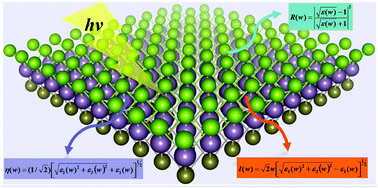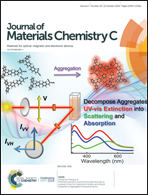An emerging Janus MoSeTe material for potential applications in optoelectronic devices†
Abstract
Motivated by the extraordinary physical and chemical properties of Janus transition-metal dichalcogenides (TMDs) due to the change of the crystal field originating from their asymmetry structures, the electronic and optical properties of the MoSeTe monolayer in 2H and 1T phases are systematically studied by first-principles calculations, and a detailed comparison with the parental MoSe2 and MoTe2 monolayer is made. It is found that 2H-MoSeTe exhibits a direct bandgap of 1.859 eV and an indirect band gap of 0.391 eV in the 1T phase, resulting in a different way to interact with sunlight. Besides, the obtained results show that the SOC has little effects on the band gaps. The calculated optical properties show a significant red shift from the MoSe2 to MoSeTe to MoTe2 monolayer. However, a blue shift is observed from the in-plane to out-of-plane direction. Moreover, both electron–electron and electron–hole correlation effects are considered for obtaining the optical spectra of systems by G0W0 and G0W0 + BSE approaches. Besides, the absorption coefficient value reaches up to 1 × 106 cm−1 in both phases, implying the high efficiency in the utilization of solar energy for the MoSeTe monolayer. Additionally, the 1T-MoSeTe monolayer is a good hot mirror material in that its maximum reflectivity could reach up to 51% in the infrared region. Additionally, the average optical absorbance of the Janus MoSeTe monolayer in the visible light region is calculated to be about 2% and the corresponding average transmittance is around 80%. More importantly, the difference in the optical response for the two side surfaces is considered in our work due to the intrinsic asymmetric structure of Janus MoSeTe. These results not only predict the great potential application of Janus MoSeTe in optoelectronics–electronic devices, but may enable the discovery of new optical science and the realization of various light emissions, detection, modulation and manipulation functions of specific frequencies.



 Please wait while we load your content...
Please wait while we load your content...